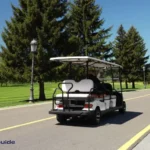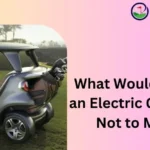A golf cart that cranks but won’t start often suffers from fuel delivery issues or spark plug problems. Inspecting these components can quickly reveal common faults.
Golf carts, much like other small vehicles, rely on a consistent and precise series of events to run smoothly. Do you know that, Why golf cart cranks but won’t start?
When your golf cart is cranking but fails to start, it can turn a leisurely day on the greens or a quick jaunt through your community into a frustrating ordeal.
As you attempt to diagnose the situation, consider the simple yet critical elements of your golf cart’s operation.
Issues such as clogged fuel filters, dead batteries, faulty spark plugs, or corroded connections can all prevent the engine from firing up.
What would cause a golf cart not to start?
Our focus is to break down the potential causes and solutions, so you won’t be left puzzled over your cart’s stubborn refusal to start.
This information aims to alleviate the anxiety of troubleshooting and gets you back to effortless cruising with minimal downtime.
The Mystery Of The Silent Golf Cart:
Imagine a perfect morning on the course, the sun peeking over the horizon, a gentle breeze, and birds chirping.
You climb into your golf cart, ready for the day, turn the key, and… nothing. The engine cranks but refuses to start.
Welcome to the mystery of the silent golf cart, an issue that frustrates many enthusiasts. Let’s delve into this dilemma.
Symptoms Of A Golf Cart That Won’t Start:
Recognizing the symptoms early can save time and headaches. Here are signs to watch for:
- Engine cranks – The starter motor engages, but the engine stays silent.
- No ignition – Despite the cranking, the cart shows no life signs.
- Odd noises – Clicks or sputtering may occur, hinting at deeper issues.
- Electrical issues – Lights dim or flicker when attempting to start.
- Common – Misconceptions About Malfunctioning Carts
Misinformation can lead to misguided attempts at repairs. Let’s clear up some common myths:
- Misconception Reality
- Dead battery means no cranking.
- A weak battery can crank but not start the engine.
- Refueling or charging solves all problems.
- Issues like faulty spark plugs or fuel filters won’t be fixed with fuel or charge.
- Jump-start will always work.
- Not effective if the problem lies within electrical components or connections.
Why golf cart cranks but won’t start?
Determining the root cause requires a thoughtful approach. A silent golf cart may keep its secrets close, but with keen observation, the mystery unravels.

Solving this puzzle restores the joy of a peaceful ride on the greens:
1. Initial Checks For Troubleshooting
Golf carts sit quietly as a staple of relaxation and convenience on the greens and around small communities. Imagine prepping for a serene afternoon only to discover your golf cart cranks but refuses to start.
The frustration! Fear not, initial troubleshooting might just be the key to reignite your cart’s spirit. Let’s get started with some basic checks.
2. Battery Condition And Connections
- Inspecting the battery is crucial to starting your cart.
- Check the charge: A fully charged battery is a happy one.
- Examine terminals: Clean terminals mean a strong connection.
3. Ensure that
- Check Item
- Action
- Battery Voltage
- Use a voltmeter
- Connections
- Tighten if loose
- Corrosion
- Clean with baking soda and water
- Fuel Level And Quality In Gas-powered Carts
A gas-powered cart needs quality fuel to start and run.
- Check fuel gauge: It tells if the tank is empty.
- Assess fuel quality: Bad fuel can prevent starting.
4. Tips for fuel check
- Signs to Look For Good to Go?
- Clear fuel lines Yes
- Freshness of fuel
- Fuel older than 30 days is a no
- Additive presence
- Good if using fuel stabilizers
- Investigating The Electrical Pathway
Picture this: You turn the key in your golf cart. You hear it crank but it just won’t start. Annoying, right?
This common issue may lie somewhere in the cart’s electrical pathway. Let’s dive into the possible electric culprits and get you back onto the course with a running cart.
5. Ignition Switch Functionality
The ignition switch serves as the gatekeeper, igniting your golf cart’s engine cycle. When it fails, the engine won’t start, even with a strong crank.
- Check the switch connections
- Test with a multimeter for current
- Look for signs of wear or damage
If the current isn’t flowing or the connections are bad, switch replacement might be necessary.
Starter Solenoid And Motor Issues
The starter solenoid acts as the intermediary between the battery and the starter motor. A faulty solenoid can stop the current, leaving the motor silent despite a turning key.
- Inspect the solenoid’s wiring
- Listen for a clicking sound when turning key
- Use a multimeter to test solenoid functionality
How do I know if my golf cart fuel pump is bad?
If the solenoid checks out, the motor may be at fault. Motors can wear out over time or suffer from bad connections. Testing motor functions can confirm if it’s time for a new one.
Delving Into Fuel System Complications
Delving into Fuel System Complications reveals more about those confounding moments when your golf cart refuses to roar to life.
It’s cranking, but there’s not a hint of ignition. The fuel system is often the hidden puzzle in this scenario. Take a deep dive with us to understand common culprits within this intricate system.
Carburetor Woes
At the very heart of the fuel system is the carburetor. Its job is mixing air and fuel just right. When it fails, so does your engine’s ability to start. Consider these carburetor-related issues:
- Dirty Carburetor: Grime and gunk clog the pathways, blocking fuel.
- Improper Adjustments: The air-fuel mixture might be off.
- Worn Components: Age can take a toll, requiring replacement parts.
- Fuel Pump And Filter Considerations
The fuel pump and filter work silently behind the scenes. Their health is pivotal for a smooth start. Look out for these issues:
- Whining Noise: A telling sign of wear.
- Sputtering Engine: Indicates inconsistent flow.
- No Pressure: A failing pump can’t move fuel.
- Struggle to Start: A dirty filter restricts flow.
- Hesitation: The engine coughs on acceleration.
- Poor Mileage: A clogged filter drinks more gas.
- The Role Of Air Flow In Engine Start
Imagine trying to blow up a balloon with a straw. Tough, right? Just like the balloon needs enough air to expand, a golf cart engine needs air to start.
Without proper airflow, even if your cart cranks, it won’t roar to life. Let’s explore the critical role air plays in starting your engine and how to ensure it flows freely.
What are the symptoms of a bad solenoid in a golf cart?
Your golf cart’s air filter is a gatekeeper, which ensures that clean air enters the engine. A dirty or clogged air filter is like a stuffy nose for your cart.

It can choke the engine, preventing it from starting. Regular maintenance is essential here:
Check the air filter often.
- Clean or replace it as needed.
- Ensure it’s properly seated in its housing.
- Intake Manifold And Choke Operation
The intake manifold is like a set of windpipes for your cart’s engine. The choke is a valve that manages the airflow during engine start-up. A malfunctioning choke can result in too much or too little air.
Here’s how to keep them in harmony:
- Inspect the intake manifold for cracks or leaks.
- Operate the choke manually to check for smooth movement.
- Look for signs of wear or damage.
Remember, proper airflow is crucial for your golf cart to start. Neglecting air filter maintenance or the intake manifold and choke operation could leave you stranded.
Keep these components clean and functioning to enjoy smooth starts and uninterrupted rides on the green.
Can you reset a golf cart?
The heart of your golf cart’s engine pulses on spark. Without a proper spark, your golf cart cranks yet refuses to start.
Understanding the importance of this tiny jolt is essential to diagnose starting issues. The engine needs three main elements: fuel, compression, and spark.
All three work in harmony. Failing that, your calm morning on the golf course could turn frustrating.
Why is spark crucial? It ignites the mix of air and fuel in the engine. It starts a chain reaction that powers everything. If the spark falters, no ignition occurs. The motor cranks but stays silent.
Spark Plug Integrity And Gaps
A spark plug’s health is critical. It must be clean and properly gapped. An old, dirty, or incorrectly spaced spark plug fails to produce the needed spark. Inspect these aspects:
- Cleanliness: Remove debris or buildup.
- Condition: Check for cracks or wear.
- Gap Size: Measure gap between electrodes.
- Replacement: Swap old plugs regularly.
Use a spark plug gap tool for precision. Set the gap to the manufacturer’s specifications.
Ignition Coil And Distributor Analysis
The ignition coil transforms battery voltage to a spark. A faltering coil could mean no spark. Test with a multimeter. Readings outside the manufacturer’s range reveal problems. Perform these checks:
- Component
- Action Expected Outcome
- Ignition Coil
- Measure resistance
- Consistent with specs
- Distributor
- Examine cap and rotor
- No cracks or wear
Remember to disconnect the battery before any tests. Secure all connections after your analysis. This ensures safety and avoids further issues.
Compression Issues
Golf carts failing to start, despite a cranking engine, often point towards compression troubles.
Just like the human heart needs to pump effectively for good health, your golf cart’s engine requires adequate compression to spring to life. Let’s dive into the mechanics.
Testing The Engine’s Compression
Identifying compression problems starts with a straightforward test. You’ll need a compression tester — a handy tool that gives you a readout of the pressure inside the engine’s cylinders.
- First, ensure the engine is off and cool.
- Remove the spark plug and insert the tester.
- Finally, crank the engine and note the reading.
A healthy engine will show strong, consistent pressure. Weak pressure signals issues.
Signs Of Low Compression And Remedies
Low compression symptoms include rough idling, misfiring, or the engine not starting at all. Should you face these issues, consider the following steps:
Sign Possible Cause Remedy:
- Hard starting Worn piston rings Replace rings
- Poor power Leaky valves Valve repair or replacement
- Rough idle Head gasket failure Replace head gasket
Regular maintenance keeps compression issues at bay. Address signs early to avoid extended downtime and costly repairs.
What causes a golf cart to just stop running?
Even the most seasoned golf cart enthusiasts can find themselves scratching their heads when their trusty vehicle cranks but refuses to roar to life.
Tackling such stubborn issues often requires moving beyond the basic checks of fuel, battery, and spark plugs.
Advanced diagnostics delve deeper to unveil those elusive problems that simple troubleshooting tips just can’t find. At this stage, precision tools and expertise take the spotlight.

Using Diagnostic Tools For Deeper Insight
Diagnostic tools provide a clearer picture of what’s happening under the hood. With these devices, each part of the engine gets tested.
These tools can read codes and monitor engine performance. The data uncovers hidden issues. Typical diagnostic devices include handheld scanners and multimeters. Here’s how they can help:
Handheld Scanners
These gadgets plug directly into the golf cart’s OBD (On-Board Diagnostics) system. They read error codes and monitor real-time engine data.
Multimeters
Essential for testing electrical components. They ensure battery, alternator, and other parts provide correct voltage and resistance.
Correct use of these tools could reveal problems like:
- Faulty sensors
- Corroded connections
- Bad switches
- When To Seek Professional Mechanic Intervention
Can a golf cart run without a solenoid?
Sometimes, Golf cart diagnosis gets tricky. Even with the right tools, you might reach a dead end. This calls for a professional mechanic’s touch. Indicators you need expert help:
Complex Error Codes:
When the diagnostic tool gives codes that are hard to decipher.
Recurring Problems:
Issues that persist, despite repairing obvious faults.
No Clear Diagnosis:
When advanced tools can’t pinpoint the exact problem.
A professional mechanic will have in-depth knowledge and tools beyond the basic diagnostics kit. This expertise ensures your golf cart not only starts but also runs at its best performance.
Maintaining Your Golf Cart For Reliability
Is your golf cart cranking but refusing to roar into life? It’s time to focus on maintenance. Reliability starts with keeping your cart in tip-top shape.
Let’s find out how regular upkeep can prevent your cart from giving you a silent treatment when you’re ready to hit the links.
Regular Maintenance Practices
To keep your golf cart running smoothly, stick to a schedule. Break these tasks down easily:
- Check the battery: Ensure it’s fully charged and free of corrosion.
- Inspect spark plugs: Clean or replace them as needed.
- Review belts and hoses: Look for wear and tear.
- Examine the air filter: Clean or change to prevent clogging.
- Test the fuel system: Fuel filters and lines need checking too.
Set reminders to never miss a service date. Your golf cart will thank you with a quick start every time.
Preventive Measures To Avoid Future Start-up Issues
Prevention is better than cure, and it’s true for golf carts as well. Here are some preventive tips:
- Store properly: Keep your cart in a dry, cool place.
- Use fresh fuel: Old fuel can cause starting problems.
- Charge regularly: Keep the battery in good health.
- Follow weight limits: Overloading can lead to issues.
- Drive with care: Rough driving can damage internal parts.
Combining these measures with regular maintenance will ensure your golf cart is reliable and ready for action.
Frequently Asked Questions For Why Golf Cart Cranks But Won’t Start?
What Causes A Golf Cart To Not Start?
Battery issues are a common reason for golf carts failing to start. Ensure the batteries are fully charged and terminals are clean.
How Do I Troubleshoot A Non-starting Golf Cart?
Begin by checking the battery voltage, ensuring connections are tight, and inspecting the spark plug and fuel system for possible faults.
Can A Bad Solenoid Cause Starting Problems?
Yes, a faulty solenoid can interrupt power flow, preventing the golf cart from starting despite the engine cranking.
Why Might A Golf Cart Crank But Not Ignite?
If the golf cart cranks but won’t ignite, look for issues with the ignition system, spark plugs, or fuel delivery problems.
What’s A Quick Fix For A Golf Cart That Won’t Start?
Check the battery charge and connections, and try cleaning or replacing the spark plug for a potential quick fix.
Related Post
How to winterize electric golf cart
What should my golf cart charger read when fully charged
What did you shoot in golf
Is hitting off a golf mat bad
What degree is a ping utility wedge
Bottom Line About Why Golf Cart Cranks But Won’t Start?
Troubleshooting a stubborn golf cart can be challenging, yet gratifying once resolved.
Remember, a non-starting cart often stems from common issues like battery problems, faulty connections, or ignition mishaps.
Regular maintenance and early detection of symptoms can save you from this hassle. Hit the course with confidence by keeping these tips in your golfing toolkit. Happy driving!












